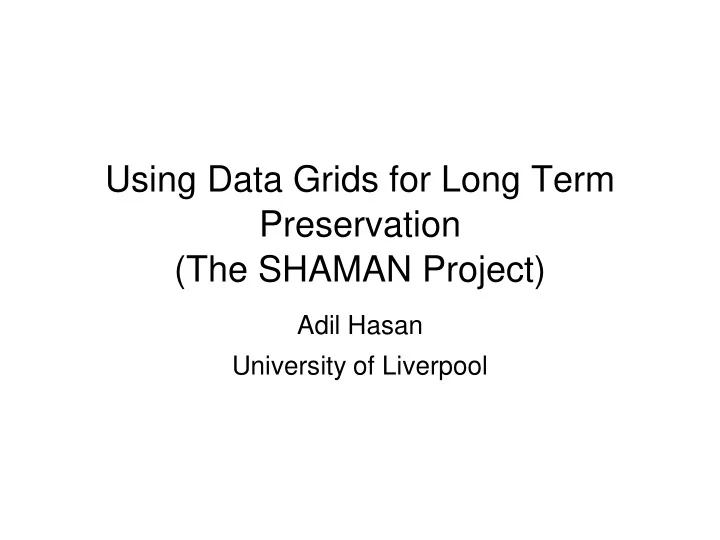

Using Data Grids for Long Term Preservation (The SHAMAN Project) Adil Hasan University of Liverpool
What is SHAMAN? • Sustaining HeritAge through Multivalent ArchiviNg. • FP7 EU Integrated Project started Dec/07 finish Dec/11. • 17 partners: DICE group (US), DNB (D), FUH (D), GLOBIT (D), HATII (GB), INCONTEC (D), INESC- ID (P), INMARK (ESP), IM (GB), Philips (NL), SSLIS (S), UGottingen (D), UIUC (US), UMagdeburg (D), ULiverpool (GB), UStrathclyde (GB), Xerox (F).
What is SHAMAN? • Aim to investigate long-term preservation of large data-sets. • Framework must guarantee future accessibility of data even when h/w and s/w change. • To ensure data understandable in future must also preserve enough context information.
The SHAMAN Approach • Decouple preservation processes from data. – Use abstract language to define preservation processes. – Possible to replace underlying services as they become obsolete. – Preservation processes themselves must be preserved. • Must also preserve enough contextual information to make sense of the data in the future.
The SHAMAN Approach • Decouple storage from data – Use data-grid to insulate from changes to hardware. – Allows system to scale by easily accommodating new hardware. – Allows system to interoperate with other systems through federation.
The SHAMAN Approach • If possible, keep data in original format and use migrateable tool to render data to end- user. – Avoids need to migrate all data regardless of access. – CPU only used to render data that needs to be accessed. – Tool has adapters to read obsolete formats. – Only need to migrate the tool forwards.
Open Archival Information System
iRODS • Provide storage virtualization – Use logical names for storage can replace storage. • Provides policy virtualization – Can use rules to implement some preservation policies which are executed by micro-services. • Provides a trusted archive – Can implement rules to check validity of data.
Multivalent presentation tool • Multivalent allows data in the original encoding format to be manipulated. • For a given data type, an adaptor (media engine) is built for the Multivalent browser – For example, PDF or Word • Multivalent services can automate required processes: – Format identification, validation, transformation (e.g. correct invalid files)
Combined Emulation/Migration approach • The Multivalent technology (Java) and the media engine are archived as an iRODS collection – Emulation consists of supporting the original operations for manipulating the digital entity • We can view documents from the original bitstream • We can introduce new functionalities to legacy documents (e.g. magnifying lens to MacWrite 1983 documents) – Migration consists of porting Java virtual machine to a new system as needed – The digital entity remains unchanged , while making it possible to apply new operations
FAB4 Fabio Corubolo
Fab4
Data Discovery • Important to ensure all contextual information preserved and discoverable. • Semantic information needs to be maintained (domain expert). • Important to ensure external references are 'managed' (either captured or an agreement exists for their long term access).
Data Discovery (Cheshire) • Discovery and retention are related! • Cheshire digital library system can be used to integrate discovery and analysis in the iRODS or SRB environments – Cheshire processing workflows can be used to combine processes of IR, association rule mining, Semantic Web, text mining • Understanding and generating digital ontologies can be used to aid discovery – Digital ontologies along with user-defined ontologies can be used in the semantic grid context
Current State • Production version of Multivalent now released and widely used. • Common media formats supported already. • Production version of Cheshire digital library now released and in service. • Work integrating Cheshire/Multivalent into iRODS now taking place. • Further research needs to be done for application to scientific/engineering domains. • Use for science/engineering domains is a realistic near-term goal!
References • Multivalent: – http://multivalent.sourceforge.net • Cheshire: – http://cheshire3.sourceforge.net • IRODS: – https://www.irods.org
Recommend
More recommend